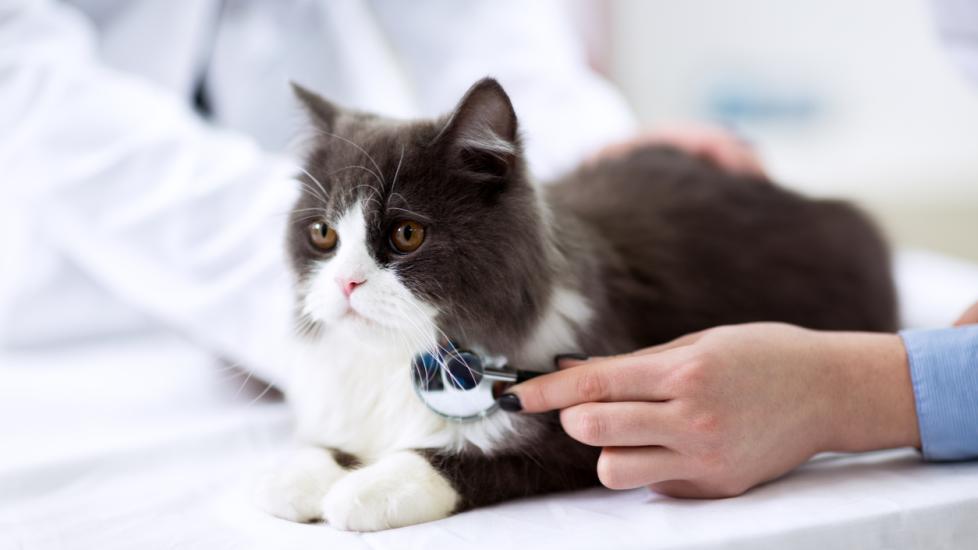Liver Disease in Cats
What Is Liver Disease in Cats?
The liver is an extremely important organ, situated behind the diaphragm and near the stomach, pancreas, and spleen. It has multiple roles, including:
-
Protein synthesis
-
Production of clotting factors and bile, which aids in digestion of foods
-
Detoxification of wastes and toxins, as well as the metabolism of drugs
-
Storage of vitamins and minerals
-
Immunologic functions
Because of its diverse role, the liver is susceptible to damage from a variety of sources, and, if affected, significant problems can occur. Inflammation results, known as hepatitis, which progresses to death of liver cells, loss of function, and eventual liver failure.
Fortunately, the prognosis can be good if caught early enough and treated appropriately.
Health Tools
Not sure whether to see a vet?
Symptoms of Liver Disease in Cats
Usually, unless in the end stages or caused by a more severe form of liver disease, most symptoms cats experience include:
-
Lethargy
-
Vomiting
-
Diarrhea
-
Inappetence
-
Weight loss
-
Unusual bruising and/or bleeding
-
Increase in thirst and urination
Jaundice (yellowing of the skin, eyes, or gums), ascites (fluid accumulation in the abdomen), or symptoms of hepatic encephalopathy and behavior changes like circling and head pressing, seizures, and coma are also noted with liver disease.
Causes of Liver Disease in Cats
Liver disease in cats has numerous causes, which often makes determining the source frustrating for veterinarians. The vet will need to consider your cat’s age, lifestyle, and environment to help narrow the cause of liver disease. For instance, obese cats are more prone to hepatic lipidosis (fatty liver disease); couple that with a period of stress (e.g., boarding) and you have the perfect environment for this disease to occur. Hepatic lipidosis occurs when excessive fat is broken down rapidly, which overwhelms the liver’s ability to process it. It then becomes stored in the liver, affecting liver function. When left unchecked, it can lead to jaundice and death.
Other causes of liver disease include:
-
Bacterial infections
-
Viral infections
-
Fungal infections
-
Parasitic infections
-
Inflammatory conditions (cholangitis/cholangiohepatitis)
-
Toxins (e.g., Tylenol, blue-green algae, sago palms)
-
Portosystemic shunts (PSS)—usually a congenital issue that often impairs the liver’s ability to detoxify wastes
The liver can also become secondarily affected by endocrine disorders such as Diabetes mellitus and hyperthyroidism and conditions affecting the gallbladder such as bile duct obstruction and cholecystitis (inflammation) or even rupture.
Cancers can also occur in the liver, as can hepatic amyloidosis—seen primarily in Persians and Abyssinians—which is an inherited condition that causes abnormal protein deposits in the liver.
How Veterinarians Diagnose Liver Disease in Cats
In addition to a physical exam and screening tests such as bloodwork and urinalysis, other blood tests may be recommended depending on the cat.
To provide an accurate diagnosis, a liver sample may be needed. This is often accomplished through surgery or a biopsy, where a needle is inserted directly into the liver.
Treatment of Liver Disease in Cats
Liver disease in cats can be curable, depending on the underlying cause. Medications and diet are often the main treatments recommended. Because the liver is responsible for many functions related to digestion and metabolism of nutrients, a diet that requires less work from the liver can be helpful. Prescription diets such as Hill’s l/d or Purina® Pro Plan® HP Hepatic are formulated to have more digestible protein, contain more antioxidants, and have lower amounts of certain minerals like copper, which can be harmful to the liver. Your veterinarian will be able to determine the appropriate diet for your cat.
Medications such as SAMe, acetylcysteine, vitamin supplements, and ursodiol are often used to treat liver disease.
Supportive care such as IV fluids, pain control, antacids, and anti-nausea medications—and even a feeding tube—might be recommended to slow disease progression and allow the liver to regenerate. In extreme cases, plasma transfusions may be necessary, and chemotherapy and/or surgery might be pursued where applicable.
Recovery and Management of Liver Disease in Cats
The liver has a unique ability to regenerate. And for some diseases, if caught early and treated aggressively, cats can have a good prognosis and go on to live a normal life. Unfortunately, for some cats where the disease is excessive or prognosis poor, humane euthanasia may be recommended.
Featured Image: iStock.com/didesign021
Help us make PetMD better
Was this article helpful?
